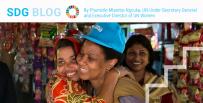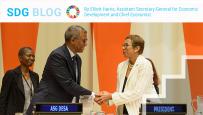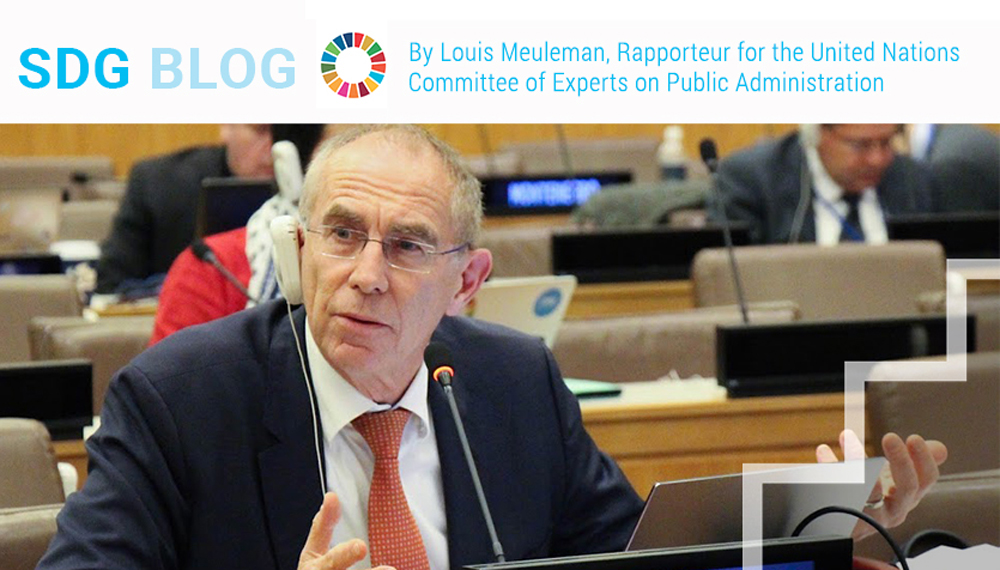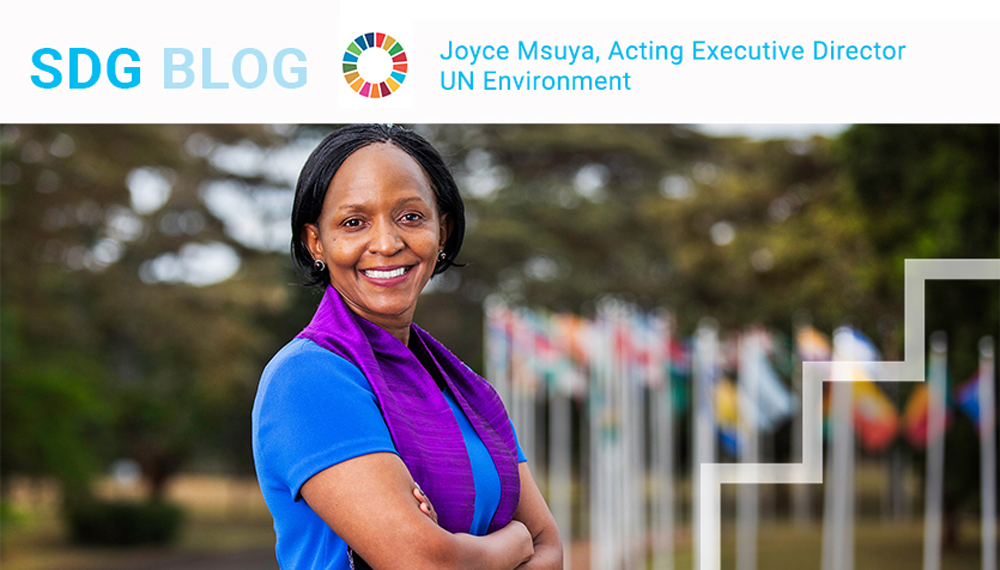 BLOG
BLOGThe theme of the 2019 High-level Political Forum on sustainable development will be "Empowering people and ensuring inclusiveness and equality” In the lead-up to the Forum, weekly blogs by representatives of Member States, UN system, and major groups and other stakeholders will be featured on this page to present various perspectives on this theme. The role of SDGs 4, 8, 10, 13, 16 and 17 will also be highlighted, as these goals will be in focus at this year’s Forum. Follow #HLPF on social media for the latest blogs and other HLPF updates.

If you wonder why gender equality is so important, just try to think of any part of the world, or even any business, where it’s possible to say that we’ve already achieved it. Whether you consider equal pay for women when they do the same job as a man; a balanced group of decision makers bringing their experience to bear on an issue in boardrooms or parliaments; or women’s full engagement in peace processes; in every case there are gaps that are holding us back from achieving the 2030 Agenda vision of an end to poverty and a peaceful, sustainable world. Those gaps are the spaces where women – and girls – are missing.
These days we’re also seeing mass gatherings of women and girls mobilizing to make their voices heard, in the global marches and online movements such as #MeToo, TimesUp, NiUnaMenos and #TotalShutdown that continue to grow around the world. Most recently, striking schoolchildren in several countries across Europe and elsewhere have been calling out for climate justice and action by policy makers. Their vibrant impatience is the hallmark of new generations of young activists whose engagement is a critical part of the road to 2030.
They are right to be impatient: progress has been made but it’s still too slow. Despite advances in girls’ enrolment in primary education, 15 million girls of primary-school age are not getting the chance to learn to read or write compared to about 10 million boys. Every year, 12 million girls marry before the age of 18. Violence against women and girls remains a global pandemic, with one in three women and girls experiencing physical and/or sexual violence in their lifetimes. Today, women hold 24 per cent of parliamentary seats globally – still only half way to parity – and the global gender pay gap stands at 23 per cent.
A good education can boost quality of life and open doors to decent work opportunities. It can give women and girls the life skills they need in order to know and claim their rights, to stand up against discrimination and violence, to become fully engaged citizens and to make decisions about their health care, including their sexual and reproductive health. It also benefits children, families and societies more broadly through poverty reduction and enhanced economic growth.
We need men and women working side by side to dismantle the barriers to gender equality. One of the biggest problems is the unequal division of household work to care for the home and family members. Women spend on average 18 per cent of their day on this unpaid work, versus 7 per cent for men. In some countries that gap is much wider. Whether it is a young girl who is pulled out of school to fetch water or a woman who works full-time and then comes home to a “second shift”, when men step up and do their fair share, women are enabled to pursue paid employment, leadership and leisure activities.
Governments and private sector leaders can play a critical role in making these choices easier, by implementing policies that support paid parental leave, affordable child care and flexible work arrangements. We can also do a great deal to change mindsets through working with partners on changing the stereotypes of men and women that appear in advertising, marketing and many forms of media and entertainment. Something as simple as changing the numbers of women who are depicted in advertising as professionals, rather than only as carers, can make an important contribution to changing what we regard as normal – and to shape a more ambitious future.
Sport can also be one of the great drivers of gender equality by teaching women and girls the values of teamwork, self-reliance and resilience. It can provide girls with social connections and a refuge from violence in their homes and communities, and help them to understand their bodies and build confidence and the ability to speak up. This is particularly important during adolescence, when many girls abandon sport, whether under pressure to conform to traditionally “feminine” stereotypes, or because of early motherhood faced by young women like Dayane Santos in Brazil, whose life was turned around by the ‘One Win Leads to Another’ programme. Similar pressures to conform to pre-set educational stereotypes can stifle girls’ engagement in the learning they need to equip them for the future.
We need to ensure that women and girls are learning the right skills for the changing world of work. Rapid technological and digital advances, including automation, robotics and artificial intelligence are leading to a loss of jobs, and raising the potential for heightened inequality, especially gender inequality. Collaborative initiatives like the African Girls Can CODE programme are combatting this challenges and building equality, through equipping participants like 15-year-old Eno Ekanem, from Abuja, Nigeria with the digital literacy and personal development skills they need to pursue education and careers in ICT and coding.
The 2030 Agenda for Sustainable Development envisages for us a world where no one is left behind, where every woman, man, girl and boy is able to live up to their full potential. Eno and Dayane show us just how important equality is to bringing lasting change, and how those changes go hand in hand with improvements for us all.

Today’s youth are the cornerstone of tomorrow’s society. How well-equipped they are with education, skills and professional experience will determine their success and our future. The Economic and Social Council (ECOSOC) Youth Forum, will take place on 8-9 April 2019, providing a platform for young leaders from around the world to engage in a dialogue among themselves and with United Nations Member States and to share ideas for advancing the 2030 Agenda for Sustainable Development, the Addis Ababa Action Agenda on financing for sustainable development, and the Paris Climate Agreement. The Forum serves as a unique space for young people to share their vision and elaborate their substantive contributions to United Nations upcoming meetings.
This month also sees the 2019 ECOSOC Forum on Financing for Development follow-up, to be held 15-18 April at UN Headquarters in New York. Among the important issues to be discussed by the Forum is finding the appropriate policy mix to make growth more inclusive and generate decent work opportunities for all.
UN DESA’s latest Monthly Briefing on the World Economic Situation and Prospects reviews global labour markets, with a focus on youth. Youth employment remains a global policy challenge. Since the global economic crisis in 2009, the number of young persons (aged 15-24) in employment has contracted by more than 15 per cent.
While this partly reflects extended education, globally, 21.2 per cent of young people were in neither employment, education nor training last year. According to ILO’s “World Employment and Social Outlook: Trends 2019”, this has long-term implications for income prospects of individuals, and over time, a high share of young people who are neither acquiring skills through education or employment acts as an obstacle to innovation and sustained economic growth.
While youth unemployment is a global problem, the challenge in Africa is particularly daunting. Africa has the youngest population in the world. Countries such as Niger, Uganda, Angola and Mozambique have a median age for their population of below 18 years, and the reduction in infant mortality coupled with slowing but still high fertility rates has translated into a significant “youth bulge” across the continent. It is estimated that about 10-12 million people in the continent are joining the labour force each year, a figure projected to rise further in the next decade. This potentially entails enormous economic benefits. Yet, translating this “youth bulge” into a “demographic dividend” critically depends on the capacity to generate productive jobs.
Future labour market situations hinge on initial experiences, including the ability to access the labour market, and on the skills and competencies acquired and continually updated through life-long education and training. A cohort of youth excluded from the labour market can negatively impact many spheres of society, making strategies for youth employment a central piece of sustainable development. Promoting youth capacity building and labour force participation with decent jobs, as well as swift school-to-work transitions remain crucial.

How does one know when countries have implemented good governance? Although a cornerstone of all developmental efforts and the sine qua non of sustainability, governance is often nebulous. As a concept, it is hard to decipher. As a practice, it is hard to pin down. We can debate endlessly over the different elements that can go into its conceptual foundations. We can apply all kinds of elaborate models of analysis to get to the bottom of it. All efforts will surely and squarely lead to our pure dazzlement by the richness of its multifarious applications around the world.
Principles of effective governance for sustainable development, developed by the Committee of Experts on Public Administration (CEPA) and endorsed by the UN Economic and Social Council (ECOSOC) last July in New York, aim to tackle precisely these features of governance: how to lucidly operationalize it so that everyone can find common ground when talking about its scope and scale; and of course, how to integrate it organically into the implementation of the 2030 Agenda for Sustainable Development so that no one is left behind.
These eleven Principles of effective governance are:
The principles bring together commonly applied strategies, many of which have been recognized and endorsed over the years in various United Nations forums, resolutions and treaties. To be exact, CEPA has identified sixty-two such strategies; and its next challenge is to weave them together in coherent and cohesive ways so that the global tapestry of governance can be made more visible and legible for everyone.
Our next step in our staunch commitment to supporting ECOSOC in its vision to promote sustainable development with human dignity is to operationalize the principles so that effective governance and public institutions can directly and vigorously feed into SDG16 and the rest of the Goals.
In its eighteenth session last month in New York, CEPA outlined a three-pronged roadmap for progress: First, efforts should be channeled towards collecting further evidence of what works and what does not, under different sets of circumstances. Second, all relevant stakeholders should be engaged in formulating and upgrading the principles. And thirdly, principles backed up with evidence-based governance indicators must form the analytical basis for assessing impact of reforms.
It is heartening to see that Member States, such as Ecuador, have expressed interest in adopting the principles towards strengthening public institutions for partnerships and effective SDG implementation. CEPA will continue its cooperation with prominent organizations in the field such as the Praia Group on Governance Statistics and The International Organization of Supreme Audit Institutions (INTOSAI) Development Initiative.
Governance is humbling in a way. There is no one right answer. Effective governance, on the other hand, is empowering. The 2030 Agenda for Sustainable Development is clear in its vision and objectives. Transformative pathways towards sustainability are many, but our steadfast commitment as humanity to march along them towards peace and progress is one.
For more information:

In India, a young entrepreneur is turning hundreds of tons of flower waste from temples into organic incense sticks, made by women. A simple, cost-effective innovation is helping generate employment, protecting our water bodies and encouraging more research into environment-friendly alternatives. In Burkina Faso, an initiative to repurpose plastic waste into clothes and other items has reduced plastic waste in dumpsites in the city of Koudougou by one-third and improved sanitation.
We have just concluded a record-breaking UN Environment Assembly in Nairobi. Close to 5,000 delegates from more than 170 countries demonstrated a global political will to urgently tackle environmental challenges including the need to transform the environmental footprints of the world’s consumers and to promote the kinds of innovations I have outlined in India and Burkina Faso.
These innovations challenge the very basis of how we treat our planet. We can no longer grow now and clean up later. We have reached the planet’s limits and, as the UN Secretary-General recently reminded us, we simply cannot negotiate with nature.
But innovations also represent some good news. When we “circle back” and see value in what we discard, everybody wins: we protect nature, build livelihoods and improve the health of people. In 2017, humanity used an estimated 90 billion tons of resources. More than 50 per cent of that was dispersed or emitted as waste, while less than 10 per cent was cycled back into the economy.
The food we waste every year, due to damp warehouses, delayed shipments, or consumers who forget their leftovers in the back of the fridge – is enough to feed the world’s hungry four times over. That’s no small matter, given that we’ll probably have another two billion mouths to feed by 2050.
Our piles of discarded smartphones, washing machines, televisions and batteries contain valuable caches of copper, silver, gold, palladium, and other precious resources. But in harvesting this valuable resource, we can generate less carbon emissions than compared to mining the earth for fresh minerals.
And thanks to some innovative thinkers, ocean plastic is now a viable raw material that’s being used to make everything from boats, running shoes, sunglasses, skateboards to carpet tiles.
If countries deliver on all that was agreed in Nairobi and implement the resolutions, we could take a big step towards a new world order where we no longer grow at the expense of nature but instead see people and planet thrive together.
Someone very wise once said, “the best way to predict the future is to create it.”
So, what does this mean practically for us? It means altering consumption habits and confronting conundrums like the fact that meat and dairy products use an overwhelming majority of farmland but constitute only a fraction of the calories we consume. It means governments investing heavily in sustainable solutions that restore nature and regenerate the biosphere. It means consumers holding companies accountable to invest in better and sustainable materials, processes and infrastructure. And it means being kinder to the environment in how we extract resources from nature.
Science has sounded a red alert and painted a future that we simply do not want. 2019 is a year of both urgency and opportunity and chance for all of us to transform the planet!